Liangdong Wang
InCo-DPO: Balancing Distribution Shift and Data Quality for Enhanced Preference Optimization
Mar 20, 2025Abstract:Direct Preference Optimization (DPO) optimizes language models to align with human preferences. Utilizing on-policy samples, generated directly by the policy model, typically results in better performance due to its distribution consistency with the model compared to off-policy samples. This paper identifies the quality of candidate preference samples as another critical factor. While the quality of on-policy data is inherently constrained by the capabilities of the policy model, off-policy data, which can be derived from diverse sources, offers greater potential for quality despite experiencing distribution shifts. However, current research mostly relies on on-policy data and neglects the value of off-policy data in terms of data quality, due to the challenge posed by distribution shift. In this paper, we propose InCo-DPO, an efficient method for synthesizing preference data by integrating on-policy and off-policy data, allowing dynamic adjustments to balance distribution shifts and data quality, thus finding an optimal trade-off. Consequently, InCo-DPO overcomes the limitations of distribution shifts in off-policy data and the quality constraints of on-policy data. We evaluated InCo-DPO with the Alpaca-Eval 2.0 and Arena-Hard benchmarks. Experimental results demonstrate that our approach not only outperforms both on-policy and off-policy data but also achieves a state-of-the-art win rate of 60.8 on Arena-Hard with the vanilla DPO using Gemma-2 model.
Infinity-MM: Scaling Multimodal Performance with Large-Scale and High-Quality Instruction Data
Oct 24, 2024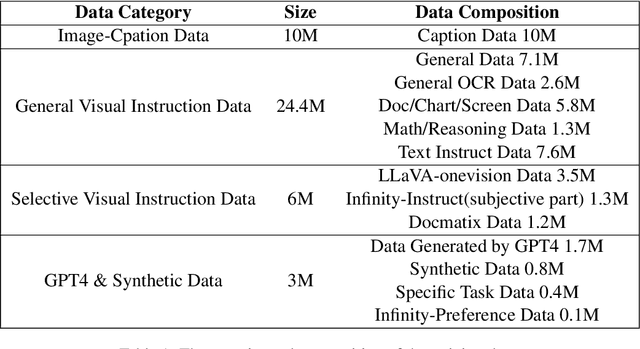
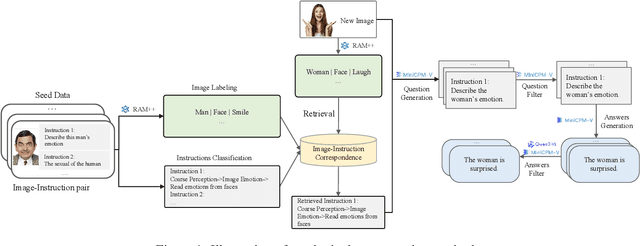
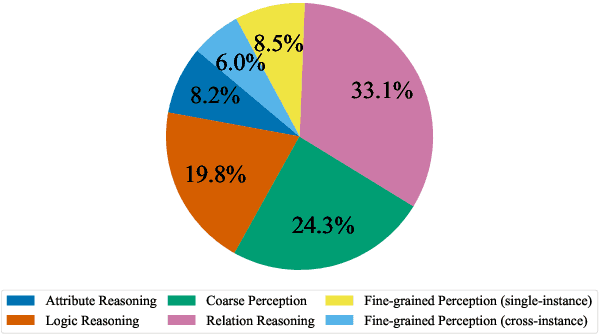

Abstract:Vision-Language Models (VLMs) have recently made significant progress, but the limited scale and quality of open-source instruction data hinder their performance compared to closed-source models. In this work, we address this limitation by introducing Infinity-MM, a large-scale multimodal instruction dataset with 40 million samples, enhanced through rigorous quality filtering and deduplication. We also propose a synthetic instruction generation method based on open-source VLMs, using detailed image annotations and diverse question generation. Using this data, we trained a 2-billion-parameter VLM, Aquila-VL-2B, achieving state-of-the-art (SOTA) performance for models of similar scale. This demonstrates that expanding instruction data and generating synthetic data can significantly improve the performance of open-source models.
CCI3.0-HQ: a large-scale Chinese dataset of high quality designed for pre-training large language models
Oct 24, 2024Abstract:We present CCI3.0-HQ (https://huggingface.co/datasets/BAAI/CCI3-HQ), a high-quality 500GB subset of the Chinese Corpora Internet 3.0 (CCI3.0)(https://huggingface.co/datasets/BAAI/CCI3-Data), developed using a novel two-stage hybrid filtering pipeline that significantly enhances data quality. To evaluate its effectiveness, we trained a 0.5B parameter model from scratch on 100B tokens across various datasets, achieving superior performance on 10 benchmarks in a zero-shot setting compared to CCI3.0, SkyPile, and WanjuanV1. The high-quality filtering process effectively distills the capabilities of the Qwen2-72B-instruct model into a compact 0.5B model, attaining optimal F1 scores for Chinese web data classification. We believe this open-access dataset will facilitate broader access to high-quality language models.
ReTok: Replacing Tokenizer to Enhance Representation Efficiency in Large Language Model
Oct 06, 2024Abstract:Tokenizer is an essential component for large language models (LLMs), and a tokenizer with a high compression rate can improve the model's representation and processing efficiency. However, the tokenizer cannot ensure high compression rate in all scenarios, and an increase in the average input and output lengths will increases the training and inference costs of the model. Therefore, it is crucial to find ways to improve the model's efficiency with minimal cost while maintaining the model's performance. In this work, we propose a method to improve model representation and processing efficiency by replacing the tokenizers of LLMs. We propose replacing and reinitializing the parameters of the model's input and output layers with the parameters of the original model, and training these parameters while keeping other parameters fixed. We conducted experiments on different LLMs, and the results show that our method can maintain the performance of the model after replacing the tokenizer, while significantly improving the decoding speed for long texts.
Emu3: Next-Token Prediction is All You Need
Sep 27, 2024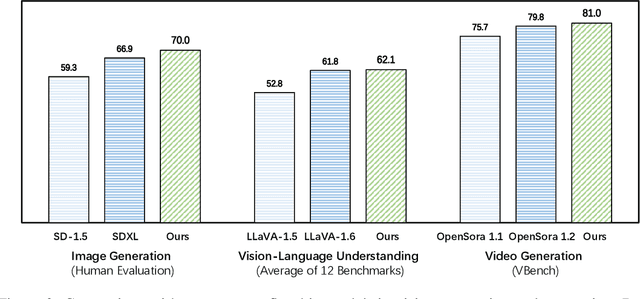

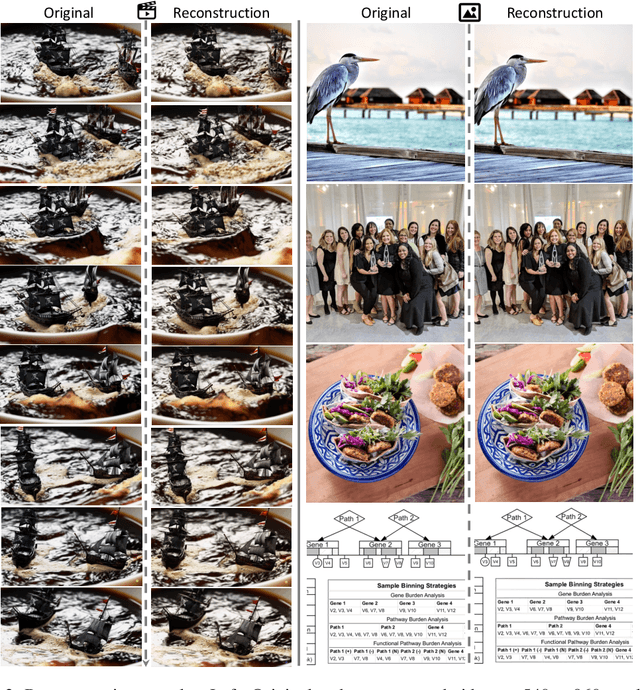
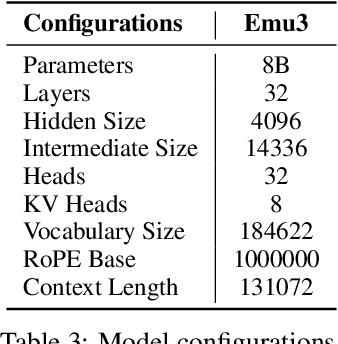
Abstract:While next-token prediction is considered a promising path towards artificial general intelligence, it has struggled to excel in multimodal tasks, which are still dominated by diffusion models (e.g., Stable Diffusion) and compositional approaches (e.g., CLIP combined with LLMs). In this paper, we introduce Emu3, a new suite of state-of-the-art multimodal models trained solely with next-token prediction. By tokenizing images, text, and videos into a discrete space, we train a single transformer from scratch on a mixture of multimodal sequences. Emu3 outperforms several well-established task-specific models in both generation and perception tasks, surpassing flagship models such as SDXL and LLaVA-1.6, while eliminating the need for diffusion or compositional architectures. Emu3 is also capable of generating high-fidelity video via predicting the next token in a video sequence. We simplify complex multimodal model designs by converging on a singular focus: tokens, unlocking great potential for scaling both during training and inference. Our results demonstrate that next-token prediction is a promising path towards building general multimodal intelligence beyond language. We open-source key techniques and models to support further research in this direction.
Aquila2 Technical Report
Aug 14, 2024Abstract:This paper introduces the Aquila2 series, which comprises a wide range of bilingual models with parameter sizes of 7, 34, and 70 billion. These models are trained based on an innovative framework named HeuriMentor (HM), which offers real-time insights into model convergence and enhances the training process and data management. The HM System, comprising the Adaptive Training Engine (ATE), Training State Monitor (TSM), and Data Management Unit (DMU), allows for precise monitoring of the model's training progress and enables efficient optimization of data distribution, thereby enhancing training effectiveness. Extensive evaluations show that the Aquila2 model series performs comparably well on both English and Chinese benchmarks. Specifically, Aquila2-34B demonstrates only a slight decrease in performance when quantized to Int4. Furthermore, we have made our training code (https://github.com/FlagOpen/FlagScale) and model weights (https://github.com/FlagAI-Open/Aquila2) publicly available to support ongoing research and the development of applications.
AquilaMoE: Efficient Training for MoE Models with Scale-Up and Scale-Out Strategies
Aug 13, 2024Abstract:In recent years, with the rapid application of large language models across various fields, the scale of these models has gradually increased, and the resources required for their pre-training have grown exponentially. Training an LLM from scratch will cost a lot of computation resources while scaling up from a smaller model is a more efficient approach and has thus attracted significant attention. In this paper, we present AquilaMoE, a cutting-edge bilingual 8*16B Mixture of Experts (MoE) language model that has 8 experts with 16 billion parameters each and is developed using an innovative training methodology called EfficientScale. This approach optimizes performance while minimizing data requirements through a two-stage process. The first stage, termed Scale-Up, initializes the larger model with weights from a pre-trained smaller model, enabling substantial knowledge transfer and continuous pretraining with significantly less data. The second stage, Scale-Out, uses a pre-trained dense model to initialize the MoE experts, further enhancing knowledge transfer and performance. Extensive validation experiments on 1.8B and 7B models compared various initialization schemes, achieving models that maintain and reduce loss during continuous pretraining. Utilizing the optimal scheme, we successfully trained a 16B model and subsequently the 8*16B AquilaMoE model, demonstrating significant improvements in performance and training efficiency.
Contrastive Cross-domain Recommendation in Matching
Dec 02, 2021



Abstract:Cross-domain recommendation (CDR) aims to provide better recommendation results in the target domain with the help of the source domain, which is widely used and explored in real-world systems. However, CDR in the matching (i.e., candidate generation) module struggles with the data sparsity and popularity bias issues in both representation learning and knowledge transfer. In this work, we propose a novel Contrastive Cross-Domain Recommendation (CCDR) framework for CDR in matching. Specifically, we build a huge diversified preference network to capture multiple information reflecting user diverse interests, and design an intra-domain contrastive learning (intra-CL) and three inter-domain contrastive learning (inter-CL) tasks for better representation learning and knowledge transfer. The intra-CL enables more effective and balanced training inside the target domain via a graph augmentation, while the inter-CL builds different types of cross-domain interactions from user, taxonomy, and neighbor aspects. In experiments, CCDR achieves significant improvements on both offline and online evaluations in a real-world system. Currently, we have deployed CCDR on a well-known recommendation system, affecting millions of users. The source code will be released in the future.
 Add to Chrome
Add to Chrome Add to Firefox
Add to Firefox Add to Edge
Add to Edge